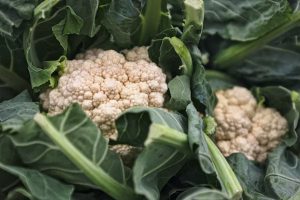Do you want to earn bulk profits from cauliflower farming? Ditch the complex ways of cauliflower cultivation and follow the 16 easy steps for adequate growth and profitable yield of cauliflower.
A step-by-step guide to implementing the organic growth of cauliflower varieties, including preparation, selection, tips, and technique to achieve high yield.
Table of Contents
15 Steps to Boost Cauliflower Production.
Introduction to Cauliflower Cultivation
Light and soil requirements for cauliflower growth
Choose a suitable place for growth.
Correct planting process of cauliflower
How to grow a massive head of cauliflower
FAQs
- Name three cauliflower varieties?
- Which seeds are best to grow cauliflower varieties?
- How to do after-care for soil?
Introduction to Cauliflower Cultivation
Cauliflower is a nutrition-packed vegetable that grows in several parts of the world in the winter season. The Cole family consists of cauliflower, Broccoli, Kale, Brussels sprouts, Collards, and Kohlrabi. The scientific name of cauliflower is Brassica oleracea var. Botrytis. The vegetable is even available in summers because of technologically supported storage.
Cauliflower dominate many Indian household meals and offer a vibrant taste to the food. The attractive color also attracts and activates appetite, boosts the metabolism, and motivates healthy functioning of the body.
Cauliflower cultivation is developing roots due to health advantages. Like broccoli is a favorite meal option of fitness or gym freaks. How often do you eat the cauliflower?
Well, here are well-tested, proven 16 ways to increase the growth of cauliflower cultivation.

-
Light and soil requirements for cauliflower growth
Sandy and loamy soil is the top preference for growing cauliflower varieties. The soil must be well-drained, moist, and rich with organic nutrients. The cauliflower extracts moist very fast from the soil to avoid buttoning in the crop. The soil’s pH level must lie between 6.5-6.8, which makes the soil acidic and indirectly protects from root diseases.
Due to improper light reach to cauliflower heads, they turn pale or yellow, which customers do not prefer. Sunlight plays a vital role in producing white head cauliflower varieties. Very often, farmers cover the head of the flower to keep them bright white
-
Pick the seed patiently
Most farmers make the same mistake of not reading information available on seed packets. It results in the crop being unsuitable for the USDA Hardiness Zone.
The maturity and growth must match the present climate as cauliflower cultivation requires 15-21 degrees temperature to harvest on time. Either sow in autumn or spring; choose seeds with a minimum maturity period with temperature acceptance or tolerance.
-
Choose a suitable place for growth
Search for a solar farm with partly shades to grow cauliflower varieties to gain all the energy from the sun. Sun’s energy will activate the growth even faster and turn into a big white head cauliflower.
The right time and care can boost cauliflower plant’s growth in mixed soil without any geographical boundaries.
-
Correct planting process of cauliflower
Prepare the land before the plantation to provide adequate growing space and air circulation. Make 30 inch gaps between rows and 18-24 between each plant. Plant the crop deep down to avoid the overweight issue during the growing phase.
The plant of cauliflower varieties requires adequate moisture and can’t stand in dry soil at high temperatures. If you want to harvest in fall, plant 8-12 weeks before the autumn’s first frost with a temperature around 23 degrees.
If the temperature falls and becomes extra cold for the crop, consider covering with old milk jugs. Covering will prevent button development.
-
How to grow a massive head of cauliflower
To grow the big head of cauliflower, opt for organic or hybrid seeds at the right temperature. It takes 50-55 days to produce the cauliflower with big heads and loads of nutrients.
-
Requirement of water
As the cauliflower varieties extract moisture from the soil, irrigation is most important but make sure to assess the soil and climate before watering. Water supply of 1 inch once a week is recommended, such that it should soak in 6-8 inches of soil. The most amount of water is needed till the germination of seeds and formation of the flower. In summer, watering once a day becomes necessary but continuously check the soil needs and climatic conditions.
-
Expand the size

Maintain the moisture in the soil; keep checking the temperature to maintain the right ecosystem for cauliflower varieties. Try to cut down the hindrance in the way of fuller crop growth. Some conditions are humidity, cold or extremely hot weather, and pests. Weeding should be done whenever needed or whenever the weed growth is observed.
-
Adequate spacing
Make rows for plantations of different cauliflower varieties to avoid confusion. Make rows with a 30-35 inches gap and a 21-25 inches gap between each plant. This practice will promote air circulation and prevent over-shadowing.
-
Removal of bolt
pluck the bolts developed in the cauliflower due to extreme hot or cold temperatures.
-
Fertilization
Fertilizers are proven heroes for boosting nutrients and moisture in the soil and high-yield crops. The cauliflower crop needs NPK(48:24:24 Kg/acre.) full doses of P and K as basal, half dose N at 15 days after transplanting and the remaining N after 45-55 days.
-
Reasons for small head
There are plenty of reasons for small head cauliflower, such as soil deficiency, seedling stress, overcrowding, climate fluctuation, inadequate drainage, less moisture, insects, and diseases.
-
Management of weed
Weed control once a week is essential. It directly protects the soil. Choose the organic options for weeding as they become a hindrance to yield.
-
Reasons for spreading heads
The reasons behind spreading heads of cauliflower varieties can be random climate fluctuation, ruined head of crop, drought, insufficient irrigation, and less nutrition through the soil.
Decrease irrigation at the maturity phase, let the flower breathe, avoid excess NPK and partly cover the farm to prevent excess rainfall water.
- Care tips for yield
- Keep an eye on beetles, worms, and other pests to save both the cauliflower heads and roots.
- Provide enough space and avoid overshadowing to promote individual growth.
- Maintain moisture in the soil, control the fertilizer portions, formulate the uncertainties, and prepare for it.
-
Preventions
Follow a few practices that directly or indirectly incorporate health into the crop. Such activities are container plantation, resistance cauliflower varieties, crop rotation, and avoiding excess nitrogen.
-
Harvesting
Once the crop reaches the growth phase, the heads grow quickly. It takes 50-70 days to ripen cauliflower varieties fully. After the leaves start turning pale, in 7-10 days it is ready to harvest.
Cut the cauliflower from the main stem with few leaves attached to it, to protect the head. Make sure to export them as soon as possible as they lose quality fast.

FAQs
Q1. Name three cauliflower varieties?
– Here are the three wide cauliflower varieties:
- First season crops include early synthetic, Pusa Katki, Early kunwar, Pant gobhi 2, and 3.
- Major season crops include Punjabi Giant 35, Pant synthetic, Punjabi Giant 26, and Pant shubhra.
- Last season crops such as Dania Kalimpong, Snowball 16, and Pusa snowball 1 and 2.
Q2. Which seeds are best to grow cauliflower varieties?
– These are the five cauliflower varieties with short maturity phases and high-temperature tolerance.
- Snow king
- Snow crow.
- Snowball 123
- Imperial -10
- Self-Blanche
Q3. How to do after-care for soil?
– The cauliflower varieties draw plenty of moisture from the soil and leave it dry. Prepare a consistent routine to keep the soil moist and fertile for the next crop session. Spread organic fertilizers, compost, manure, vermin-waste, liquid fertilizers, and proper irrigation.
Note: The information contained herein is for informational purposes only. Nothing herein shall be construed to be financial or legal advice. Pesticides are a considerable risk of loss in crops and viewers are advised to do their own research before making any decisions.





